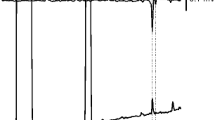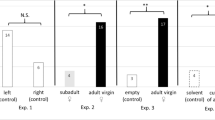Abstract
The adult female bolas spider Mastophora hutchinsoni feeds exclusively on attracted males of a few moth species. This exclusivity and the behavior of the approaching moths suggest that the spider aggressively mimics the sex pheromones of its prey species. Males of the bristly cutworm, Lacinipolia renigera, are a major prey of this spider, accounting for about two thirds of the biomass of prey consumed. Female bristly cutworms produce a pheromone blend consisting of (Z)-9-tetradecenyl acetate (Z9–14 : Ac) and (Z,E)-9,12-tetradecenyl acetate (ZE-9,12–14 : Ac). To determine if M. hutchinsoni females mimic the sex pheromone components and blend ratio of L. renigera, we collected volatiles from hunting adult female spiders and analyzed them with gas chromatography–electroantennographic detection (GC-EAD) and gas chromatography–mass spectrometry (GC-MS). GC-EAD analysis of volatile collections, using a male bristly cutworm antenna as the detector and two capillary columns of different polarities, revealed the presence of peaks with retention times (R ts) identical to Z9–14 : Ac and ZE-9,12– 14 : Ac. The mass spectrum of a peak with R t of Z9–14 : Ac was identical to the mass spectrum of the synthetic equivalent. There was an insufficient quantity of the compound with R t of ZE-9,12–14 : Ac to get a full spectrum, but selective detection of ions at m/z 61 and 192 at the correct R t supported the identification. On average, the blend collected from spiders contained 54.8 ± 20.8 (SE) pg/min of Z9–14 : Ac and 2.5 ± 1.7 (SE) pg/min of ZE-9,12–14 : Ac. The latter, on average, comprised 2.6 ± 0.7% of the total, which is similar to the blend ratio emitted by bristly cutworm females. Our results indicate that the adult female M. hutchinsoni produces an allomone blend that mimics not only the composition, but also the blend ratio, of the sex pheromone of a major prey species.
Similar content being viewed by others
REFERENCES
Baker, T. C., Gaston, L. K., Pope, M. M., Kuenen, L. P. S., and Vetter, R. S. 1981. A highefficiency collection device for quantifying sex pheromone volatilized from female glands and synthetic sources. J. Chem. Ecol. 7:961–968.
CardĚ, R. T., and Charlton, R. E. 1984. Olfactory sexual communication in Lepidoptera: Strategy, sensitivity and selectivity, pp. 241–265, in T. Lewis (ed.). Insect Communication. Academic Press, London.
Clark, J. D., and Haynes, K. F. 1990. Sex attractant for the bluegrass webworm (Lepidoptera: Pyralidae). J. Econ. Entomol. 83:856–859.
Eberhard, W. G. 1977. Aggressive chemical mimicry by a bolas spider. Science 198:1173–1175.
Eberhard, W. G. 1980. The natural history and behavior of the bolas spider Mastophora dizzydeani sp. n. (Araneidae). Psyche 87:143–169.
Haynes, K. F. 1990. Identification of sex pheromone of bristly cutworm, Lacinipolia renigera (Stephens). J. Chem. Ecol. 16:2615–2621.
Haynes, K. F., Yeargan, K. V., Millar, J. G., and Chastain, B. B. 1996. Identification of sex pheromone of Tetanolita mynesalis (Lepidoptera: Noctuidae), a prey species for bolas spider, Mastophora hutchinsoni. J. Chem. Ecol. 22:75–89.
Jennings, W. 1980. Gas Chromatography with Glass Capillary Columns, 2nd ed. Academic Press, New York.
Leonhardt, B. A., Devilbiss, E. D., and Klun, J. A. 1983. Gas chromatographic mass spectrometric indication of double bond position in monounsaturated primary acetates and alcohols without derivatization. Org. Mass Spectrom. 18:9–11.
Pringle, J. W. S. 1938. Proprioreception in insects. I. A new type of mechanical receptor from the palps of the cockroach. J. Exp. Biol. 15:101–113.
Shorey, H. H., and Hale, R. L. 1965. Mass-rearing of the larvae of nine noctuid species on a simple artificial medium. J. Econ. Entomol. 58:522–524.
Sokal, R. R., and Rohlf, F. J. 1995. Biometry, 3rd ed. W. H. Freeman, New York.
Stowe, M. K., Tumlinson, J. H., and Heath, R. R. 1987. Chemical mimicry: Bolas spiders emit components of moth prey species sex pheromones. Science 236:964–967.
Struble, D. L., and Arn, H. 1984. Combined gas chromatography and electroantennogram recording of insect olfactory responses, pp. 161–178, in H. E. Hummel and T. A. Miller (eds.). Techniques in Pheromone Research. Springer-Verlag, New York.
Whitaker, R. H., and Feeny, P. P. 1971. Allelochemics: Chemical Interactions between species. Science 171:257–270.
Yeargan, K. V. 1988. Ecology of a bolas spider, Mastophora hutchinsoni: Phenology, hunting tactics, and evidence for aggressive chemical mimicry. Oecologia 74:524–530.
Yeargan, K. V. 1994. Biology of bolas spiders. Annu. Rev. Entomol. 39:81–99.
Yeargan, K. V., and Quate, L. W. 1996. Juvenile bolas spiders attract psychodid flies. Oecologia 106:266–271.
Yeargan, K. V., and Quate, L. W. 1997. Adult male bolas spiders retain juvenile hunting tactics. Oecologia 112:572–576.
Author information
Authors and Affiliations
Rights and permissions
About this article
Cite this article
Gemeno, C., Yeargan, K.V. & Haynes, K.F. Aggressive Chemical Mimicry by the Bolas Spider Mastophora hutchinsoni: Identification and Quantification of a Major Prey's Sex Pheromone Components in the Spider's Volatile Emissions. J Chem Ecol 26, 1235–1243 (2000). https://doi.org/10.1023/A:1005488128468
Issue Date:
DOI: https://doi.org/10.1023/A:1005488128468




